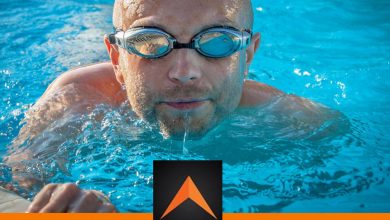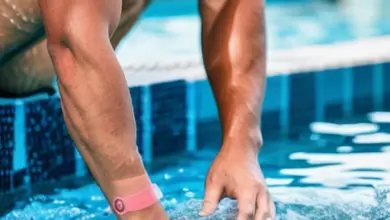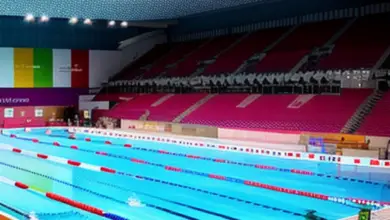How To Improve Lung Capacity For Swimming
Are you struggling to keep up with the school of fish gliding effortlessly through the water? Do your lungs feel like they’re about to burst while swimming even a short distance? Don’t worry, my fellow aspiring fish, you’re not alone! Swimming is not only an art but also a skill involving incredible strength, endurance, and lung capacity. Developing a superior lung capacity isn’t an overnight achievement, but with determination and patience, you can definitely breathe life into your swimming performance.
In this extraordinary journey towards aquatic mastery, we’ll explore the depths of our lungs to unlock their full potential and help you swim like a dolphin. Be prepared to dive into the world of breathing techniques, training exercises, and valuable tips that can significantly improve your lung capacity for swimming. But don’t hold your breath; let us take the plunge and show you how to transform every breath you take underwater into a symphony of aquatic prowess.
Importance of Lung Capacity for Swimmers
In the world of swimming, having excellent lung capacity is of paramount importance for every swimmer, irrespective of their preferred stroke. Swimmers with higher lung capacity experience better lung function, ensuring that they have an optimal supply of oxygen available to generate anaerobic energy. This advantage not only helps to improve overall performance but also significantly impacts the swimmer’s ability to float, leading to better body position in the water.
Watching a 50-meter freestyle final at World Championships or the Olympics, one can observe that swimmers take an average of only one or two breaths throughout the race. This demonstrates the vital role that lung capacity plays in competitive swimming. Contrary to popular belief, having good lung capacity does not merely mean being able to hold your breath longer; it is integral to all four swimming strokes.
Swimmers can improve their lung capacity through specific exercises, such as deep breathing, coordinating breaths with arm strokes, and limiting the number of breaths over a certain distance. With commitment to regular practice, swimmers can reap the benefits of increased lung capacity, which will ultimately translate to enhanced efficiency, endurance, and performance in the pool.
Spirometry Test: Measuring Lung Function
A spirometry test is a crucial tool in assessing a person’s lung function and capacity, which can be especially important for swimmers aiming to improve their performance. This non-invasive medical test measures the volume of air a person can inhale and exhale, as well as the speed at which it is done. To perform a spirometry test, a person is asked to breathe into a machine called a spirometer, which records the results.
There are two critical values obtained from a spirometry test: FEV1 (Forced Expiratory Volume in 1 second) and FVC (Forced Vital Capacity). FEV1 represents the amount of air a person can exhale forcibly in 1 second, while FVC demonstrates the total volume of air that can be exhaled after taking a deep breath. Doctors calculate the results of these tests as a percentage, comparing it to the normal value for someone of the same height, age, sex, and race.
Regularly conducting a spirometry test can help identify any underlying lung conditions, such as COPD (Chronic Obstructive Pulmonary Disease) or asthma. Additionally, it can also help monitor the progression and effectiveness of any prescribed treatments for these conditions. In the context of swimming, understanding one’s lung function and capacity is vital for optimizing performance, ensuring swimmers can make informed decisions about their training and breathing techniques.

Exercise 1: Deep Breathing Techniques
Improving lung capacity for swimming is essential to enhance performance and reduce fatigue during this highly cardiovascular sport. One effective method to achieve this is by practicing deep breathing techniques. Regularly engaging in these exercises can greatly benefit a swimmer’s lung function, allowing for better oxygen availability and improved anaerobic energy function.
One simple deep breathing technique that can be performed at home involves taking slow, deep breaths in and out. Begin by inhaling as deeply as possible and holding the breath for five seconds. Next, exhale completely and pause for another five seconds before repeating the cycle. Aim to take at least 10 deep breaths in this manner. This exercise not only helps in increasing lung capacity, but also contributes to relaxation.
Swimmers can also practice timed breathing in line with their arm strokes. This can be done by alternating breathing patterns every 2, 3, 4, 5, 6, 7, 8, or 9 strokes when swimming freestyle. This exercise helps improve lung function and can be performed during both easy and hard swimming sessions.
Incorporating deep breathing techniques into a swimmer’s regular training routine can lead to significant improvements in lung capacity and overall performance in the water.
Exercise 2: Alternate Breathing in Freestyle
Swimming efficiently requires good breathing technique, and alternate breathing in freestyle can help to improve your lung capacity while maintaining a smooth swimming rhythm. This exercise focuses on varying the number of strokes between each breath, which can optimize your oxygen intake and promote balanced body positioning in the water.
To begin, start with a comfortable, relaxed swimming pace. Begin by taking a breath every two strokes, then increase the number of strokes between breaths to three, four, five, and so on. As your lungs adapt to this exercise, try to consistently increase the number of strokes before each breath, eventually reaching a point where you are breathing every nine strokes. Keep in mind that it is important to maintain good form during the process, ensuring that your head and body stay aligned and straight.
Alternate breathing in freestyle can be practiced during both easy and challenging pool sessions. You can incorporate this exercise into various swim sets, gradually increasing the intensity as your lung capacity improves. Over time, you will notice an increased ability to swim longer distances with fewer breaths, resulting in a more efficient and enjoyable swimming experience. Remember to always listen to your body and never push yourself beyond your limits.
Exercise 3: Breathing a Set Number of Times
An effective technique for improving lung capacity in swimmers is to establish a set number of breaths taken over a certain distance while swimming. This exercise helps in better controlling the breathing and increasing the efficiency of lung function, assisting in longer and faster swims.
To begin with, determine the maximum number of breaths to be taken per lap of the pool. This should be a challenging, yet achievable number, as the aim is to push your limits and gradually enhance lung capacity. Start by swimming a distance of 300 to 400 meters and progressively increase the intensity over time. Additionally, this exercise can be carried out while swimming at both easy and more challenging paces.
It is important to maintain focus and relaxation while performing this breathing exercise. Engaging the mind in other activities or thoughts, essentially “switching off,” can aid in better managing the mental aspect of this exercise. Consistent practice of this technique can result in improved swimming efficiency, allowing swimmers to cover greater distances with less effort.
In summary, swimming Exercise 3 – Breathing a Set Number of Times – encourages swimmers to enhance their lung capacity, overall technique, and mental control, ultimately leading to improved swimming performance.
Conserving Oxygen: Kicking Lighter Than Normal
Swimming is an extremely cardiovascular sport that requires a good amount of oxygen to fuel the body. As the body’s largest muscles, the quadriceps, or thigh muscles, demand the most oxygen. Thus, it is essential to conserve oxygen while swimming to increase overall lung capacity and enhance performance. One practical way to achieve this is by kicking lighter than normal during your swim.
Kicking lightly doesn’t mean that you’re compromising your pace or technique. Instead, it helps you conserve oxygen, allowing you to swim for more extended periods without feeling exhausted. By focusing on a more relaxed kicking motion, you also avoid tension in your legs, further conserving energy for your overall swim performance.
When kicking lighter, ensure that you maintain proper form and technique. Engage your core muscles while keeping your legs straight and near the surface of the water. This streamlined position will help you glide through the water more efficiently, supporting better oxygen consumption and lung capacity.
Gradually incorporating lighter kicking into your swim training can yield significant improvements in your lung capacity and overall performance. Remember to maintain proper technique, focus on your breathing pattern, and listen to your body as you progress. By conserving oxygen and supporting your body’s demand for air, you’ll be able to swim farther and faster, ultimately enhancing your overall swimming experience.
Breath Control Sets: Long Duration or Low-Frequency Breathing Pattern
Breath control sets are an effective way to enhance your lung capacity and improve your overall swimming performance. These sets involve either holding your breath for longer durations or practicing a low-frequency breathing pattern during your swim workouts. By incorporating these exercises into your training regimen, you can develop better breathing techniques that will help you conserve oxygen and maintain a steady pace in the water.
Long duration breath control sets require swimmers to hold their breath for an extended period, such as swimming a 25 or 50-meter freestyle lap without taking a breath. Remember to maintain a moderate kicking pace and exhale slowly to avoid oxygen depletion. Gradually increase the distance or time you hold your breath as your lung capacity improves.
On the other hand, low-frequency breathing pattern exercises involve taking breaths at a slower rate, such as once every five, seven, or even nine strokes. By challenging yourself with these less frequent breathing patterns, you can gradually increase your lung capacity while also working on your stroke technique and balance in the water.
In summary, incorporating breath control sets with either long duration or low-frequency breathing patterns into your swim training can significantly enhance your lung capacity and overall endurance. Practice these exercises consistently, and you’ll soon notice a marked improvement in your swimming abilities.
No-Breathers: Increasing Lung Capacity
One of the key factors that contributes to a swimmer’s performance is their lung capacity. By enhancing lung capacity, swimmers can improve their efficiency and endurance in the pool. This is especially important for competitive swimmers, who often rely on their lung capacity to get through high-intensity races and training sessions. Here are a few exercises and techniques to increase lung capacity and become a better swimmer.
Firstly, practice breathing in and out as deeply as possible at home. Take 10 deep breaths, holding each breath for at least five seconds before exhaling completely and repeating the exercise. This not only increases your lung capacity but also helps in relaxation.
Secondly, when swimming freestyle, try alternating your breathing pattern, taking breaths every 2 to 9 strokes. This can be done during both easy and hard swimming sessions, and helps your lungs adapt to varying breathing rhythms.
Thirdly, set a maximum number of breaths per lap while swimming. Start with a manageable number and gradually reduce it as your lung capacity improves. This can be done during both easy and hard swimming sessions, gradually increasing the intensity over time.
Lastly, remember to exhale while underwater and inhale when coming up for air. This simple yet effective technique ensures your lungs get adequate oxygen, reducing stress on the bronchus, and ultimately, improving your lung capacity. Don’t forget – practice makes perfect! Stick to these exercises and techniques, and you’ll see a remarkable improvement in your lung capacity and overall swimming performance.
Underwater Lap Swimming: Building Stamina
One effective way to increase lung capacity and build stamina for swimming is through underwater lap swimming. This practice helps swimmers improve their lung function by focusing on breath control and increasing the amount of time they can hold their breath underwater. By working on underwater lap swimming, swimmers can not only improve their lung capacity but also their overall swimming performance, as better breath control translates to increased efficiency and stamina in the water.
To practice underwater lap swimming, you should start by attempting to swim a lap in the pool while remaining completely submerged. You can perform various underwater techniques such as kicking in a streamlined position, performing breaststroke pull-downs, or creating your own method. The goal is to complete the entire lap underwater, without surfacing for air. If you cannot complete the full lap, take note of how far you make it before needing to take a breath, and work on increasing that distance over time.
Between each underwater lap, it is crucial to catch your breath properly, allowing your lungs to recover before attempting the next lap. Gradually increase the number of underwater laps you complete during practice sessions, which will help to improve your lung capacity, swimming stamina, and overall performance in the water. Remember to always practice this technique safely and under proper supervision.
Breathing Every 5, 7, or 9 Strokes: Balancing Out Your Stroke
Improving lung capacity is essential for swimmers who want to increase their stamina and performance in the water. One effective exercise to achieve this goal is to practice breathing every 5, 7, or 9 strokes. This technique not only enhances lung capacity but also helps in balancing your stroke, making it an efficient and productive training exercise.
By incorporating this breathing pattern into your swimming routine, you can steadily build up your lung capacity and maintain a smoother, more balanced stroke. Start by taking a breath every 5 strokes during the first lap, then increase to 7 strokes in the second lap, and alternate between the two as you progress. As you become more comfortable with this pattern, challenge yourself to hold your breath for 9 strokes, gradually increasing your lung capacity and overall stamina.
Aside from its physical benefits, this exercise trains your body to utilize oxygen more efficiently, allowing you to swim at a faster pace for extended periods. Additionally, adopting this breathing pattern promotes mental discipline, as it forces you to concentrate and control your breath while swimming.
In conclusion, practicing breathing every 5, 7, or 9 strokes not only boosts lung capacity but also contributes to a more balanced and efficient stroke. By incorporating this technique into your swimming routine and pushing yourself to go the extra distance, you can significantly improve your performance in the water.








